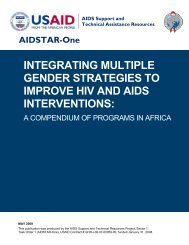Guide for Community Assessments on Women's Health Care - ICRW
Guide for Community Assessments on Women's Health Care - ICRW
Guide for Community Assessments on Women's Health Care - ICRW
You also want an ePaper? Increase the reach of your titles
YUMPU automatically turns print PDFs into web optimized ePapers that Google loves.
Steps:<br />
➊ GROUP PRESENTATIONS: Take each topic <strong>on</strong>e at a time and get each group to explain what they<br />
produced.<br />
a) BODY MAPS & PRIORITY HEALTH ISSUES – Ask each group to present its priority health issues.<br />
Write up the comm<strong>on</strong> issues <strong>on</strong> a new flipchart and get the group to agree <strong>on</strong> them. Clarify why<br />
they regard each issue as a priority. (See sample below.)<br />
Priority Issue<br />
HIV and AIDS<br />
Sexually transmitted<br />
infecti<strong>on</strong>s (STIs)<br />
Cancer – breast,<br />
cervical & uterine<br />
Tuberculosis (TB)<br />
Malaria<br />
Violence against<br />
women<br />
Why Priority?<br />
Leading cause of death. Results – orphans, loss of income and poverty.<br />
Women highly vulnerable to HIV due to lack of power to make decisi<strong>on</strong>s<br />
re: sexual activity.<br />
Stigma and lack of knowledge prevents women from getting treatment.<br />
Taboos prevent women from talking about STIs.<br />
Low knowledge about cancer am<strong>on</strong>g women and health workers. Lack of<br />
services to detect or treat cancer.<br />
Dangerous, highly stigmatized and highly prevalent am<strong>on</strong>g vulnerable<br />
populati<strong>on</strong>s such as people living with HIV.<br />
Major cause of death. Affects large % of populati<strong>on</strong>. Mosquito nets too<br />
expensive <str<strong>on</strong>g>for</str<strong>on</strong>g> many women.<br />
Experienced by large % women. Major cause of injuries, stress,<br />
depressi<strong>on</strong> and HIV.<br />
Note: Use the differences am<strong>on</strong>g groups to drive the discussi<strong>on</strong>. For example the women might<br />
name sexually transmitted infecti<strong>on</strong>s as a priority, while the service providers might not menti<strong>on</strong><br />
STIs at all. If this happens, ask the group questi<strong>on</strong>s, such as: Why have the women rated sexually<br />
transmitted infecti<strong>on</strong>s as a high priority, while the health workers have not menti<strong>on</strong>ed it? Do the women<br />
go to the health workers <str<strong>on</strong>g>for</str<strong>on</strong>g> treatment, or to the local healers? How can health workers change their<br />
practices so that more women come to them <str<strong>on</strong>g>for</str<strong>on</strong>g> treatment?<br />
b) GAPS IN SERVICES: Use the same process.<br />
c) BARRIERS PREVENTING WOMEN FROM ACCESSING SERVICES<br />
Note: Keep a list of participants’ questi<strong>on</strong>s. Explain that a later sessi<strong>on</strong> will go over these issues and<br />
provide answers.<br />
Chapter C: Facilitating <str<strong>on</strong>g>Community</str<strong>on</strong>g> Assessment Workshops 57

















